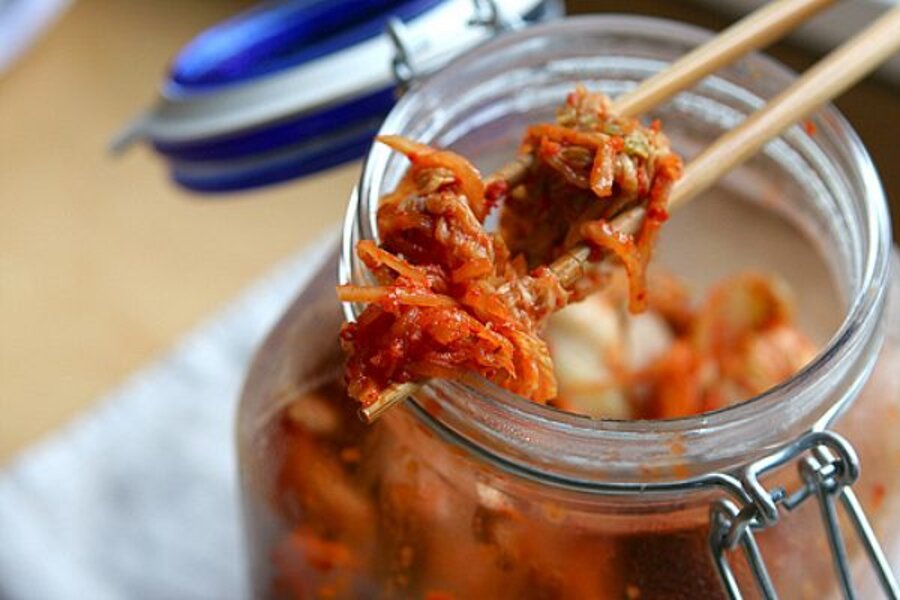By Sarah Murphy-Kangas, In Praise of Leftovers
For the kimchi paste
1 cup gochu garu (coarse Korean red pepper flakes)
3 Tbs. dark brown sugar
1 Tbs. kosher salt or sea salt
1 medium apple, unpeeled, cored and quartered
1/2 medium yellow onion, peeled
6 to 8 oil-packed anchovy fillets, drained
5 medium cloves garlic, peeled
1 oz. (about 1 inch) fresh ginger, peeled and thickly sliced
For the kimchi
1 (2-lb.) napa cabbage, trimmed, cut lengthwise into 8 sections, then crosswise into 2- to 3-inch rectangular pieces (about 15 cups)
2 Tbs. plus 1 tsp. kosher salt or sea salt
3/4 lb. daikon radish, peeled and cut into matchsticks (about 2 cups)
1 tsp. granulated sugar
8 to 10 scallions, halved lengthwise and then cut crosswise into 2-inch pieces
5 medium cloves garlic, cut into matchsticks 2 oz. (about 2 inches) fresh ginger, peeled and cut into matchsticks
Make the kimchi paste
1. In a medium bowl, combine the gochu garu with 1/2 cup water. Add the sugar and salt and mix well. Set aside.
2. In a food processor, purée the apple, onion, anchovies, garlic, and ginger until smooth. Add the purée to the red pepper paste and mix thoroughly. Refrigerate the paste in an airtight container for at least 24 hours before using. It will keep for up to 3 months in the refrigerator.
Prepare the kimchi
1. Put a third of the cabbage in an extra-large bowl. Sprinkle with 2 tsp. of the salt. Top with another third of the cabbage and sprinkle with 2 tsp. salt. Repeat with the remaining cabbage and 2 tsp. salt. Put a piece of plastic wrap directly on the cabbage and then weigh down with four 1-lb. cans. Let the cabbage rest at room temperature for 3 hours.
2. Remove the cans, transfer the cabbage to a colander, rinse briefly, and let drain. Clean the bowl. Take handfuls of the cabbage, squeeze out any excess liquid, and put the squeezed cabbage in the bowl; set aside.
3. In a medium bowl, combine the daikon, the remaining 1 tsp. salt, and the sugar. Let rest for 15 minutes.
4. With your hands, rub the daikon strips until they’re soft and pliable. Drain the daikon in a colander. Wipe out the bowl. Gather the daikon into a ball and squeeze out any liquid; return to the bowl.
5. Add the scallions, garlic, and ginger to the daikon and toss to distribute. Add the daikon mixture to the cabbage and toss again.
6. Open a gallon-size-zip-top bag; set aside. Wearing disposable plastic gloves, use your hands to mix 3/4 cup of the kimchi paste with the cabbage mixture. Be sure the cabbage mixture is thoroughly coated with the kimchi paste; season to taste with salt.
7. Put the cabbage in the plastic bag. Remove and discard the gloves. Seal the bag three-quarters of the way.
8. Starting from the bottom of the bag, roll the bag forward to expel air. Try to prevent liquid from seeping out of the bag. When you have almost reached the top, seal the bag completely. Unroll the bag and put it on a baking sheet. Let the kimchi ferment at room temperature for 24 hours.
9. Transfer the kimchi and its liquid to a sterile wide-mouth 1.5-liter (or half-gallon) glass jar and refrigerate. (The kimchi should be stored in one jar, not divided into multiple jars.) It will be ready after 24 hours, though some may prefer the more fermented taste the kimchi acquires after 2 to 3 days. Kimchi will last in the refrigerator for at least 4 weeks.
See the full post on Stir It Up!








